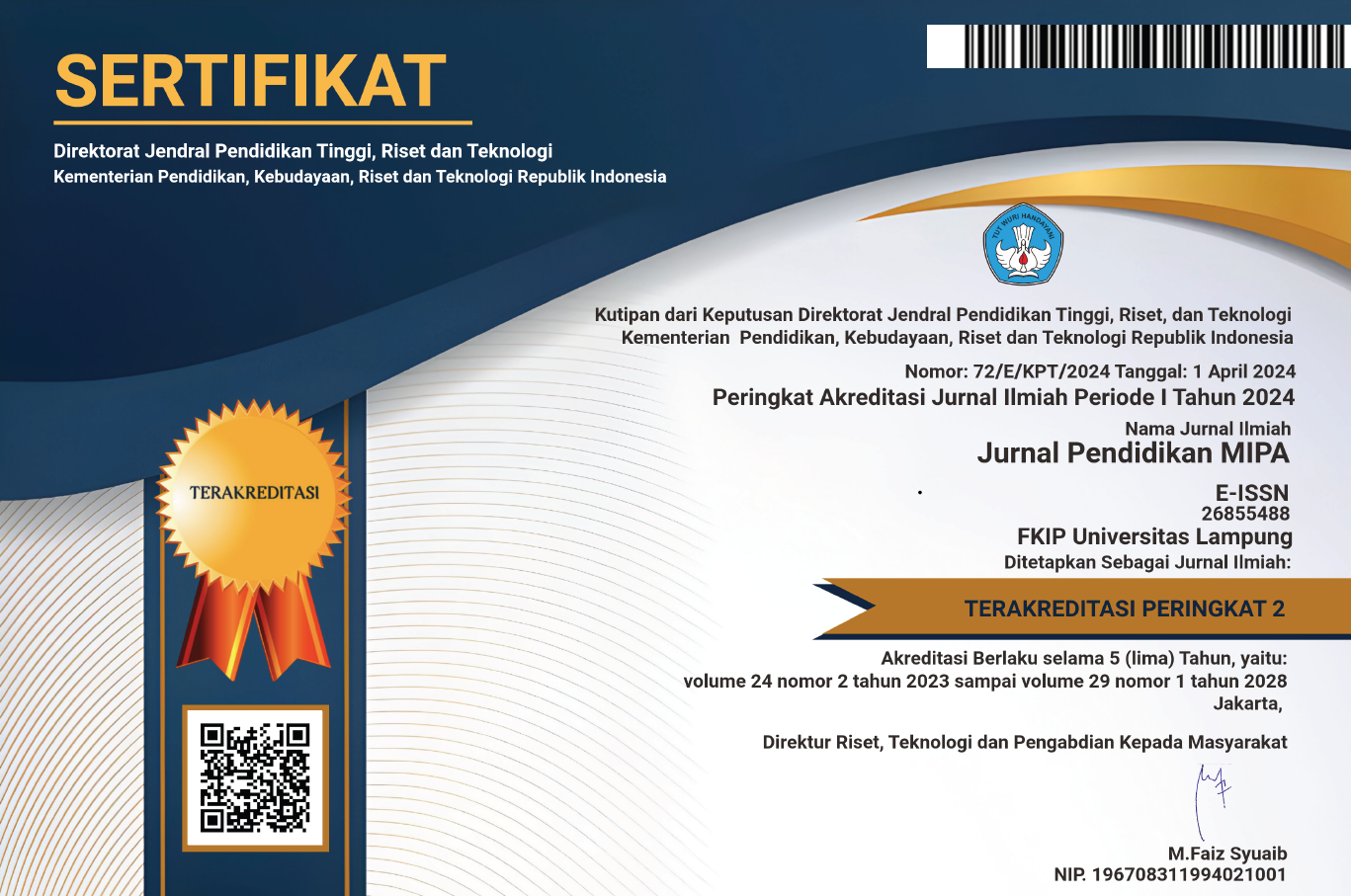Implementation of the Flipped Classroom Learning Model to Improve Students' Self-Regulated Learning
 Country:
Country:
(1) Universitas Sarjanawiyata Tamansiswa, Indonesia
(2) Universitas Sarjanawiyata Tamansiswa, Indonesia
(3) Universitas Sarjanawiyata Tamansiswa, Indonesia
This study aims to determine the effectiveness of the Flipped Classroom learning model in terms of self-regulated learning on student learning outcomes. This study used a quasi experimental design in SMP Muhammadiyah 1 Gamping with the subject of the study being the experimental group totaling 32 students and the control group totaling 32 students. Based on the result of data analysis shows that the application of the Flipped Classroom learning model is more effective than application of the direct learning model and has a significant interaction between the learning model and the self-regulated learning. This can be strengthened by the result of interactions with the learning model and the self-regulated learning of Sig=0,044<0,05 so that the learning model affects the self-regulated learning of students. The Flipped Classroom learning model can be used in mathematics as an alternative learning model, especially in flat face three dimensional objects.
Keywords: effectiveness, flipped classroom learning model, self-regulated learning, learning outcomes
Atzori, L., Iera, A., & Morabito, G. (2017). Understanding the Internet of Things: definition, potentials, and societal role of a fast evolving paradigm. Ad Hoc Networks, 56, 122–140. https://doi.org/10.1016/j.adhoc.2016.12.004
Boekaerts, M. (1999). Self-regulated learning: where we are today. International Journal of Educational Research, 31, 445–457.
Cahyati, S. S., Tukiyo, T., Saputra, N., Julyanthry, J., & Herman, H. (2022). How to Improve the Quality of Learning for Early Childhood? An Implementation of Education Management in the Industrial Revolution Era 4.0. Jurnal Obsesi: Jurnal Pendidikan Anak Usia Dini, 6(5), 5437–5446. https://doi.org/10.31004/obsesi.v6i5.2979
Custodio, Á., Estrada, M., Vera, J. G., Ruiz, G. R., & Arrebola, I. A. (2019). Flipped Classroom to Improve University Student Centered Learning and Academic Performance. Social Sciences, 8(11), 315.
Gikas, J., & Grant, M. M. (2013). Mobile computing devices in higher education: Student perspectives on learning with cellphones, smartphones & social media. Internet and Higher Education, 19, 18–26. https://doi.org/10.1016/j.iheduc.2013.06.002
Gómez, D. G., Jeong, J. S., Rodríguez, D. A., & Florentina. (2016). Performance and Perception in the Flipped Learning Model: An Initial Approach to Evaluate the Effectiveness of a New Teaching Methodology in a General Science Classroom. Journal of Science Education and Technology, 25(3), 450–459. https://doi.org/10.1007/s10956-016-9605-9
Gunuç, S., & Babacan, N. (2017). Technology Integration in English Language Teaching and Learning. The Journal of Teaching English for Specific and Academic Purposes, 5, 349–358. https://doi.org/10.22190/JTESAP1702349G
Irfan, M., Kusumaningrum, B., Yulia, Y., & Widodo, S. A. (2020). Challenges During The Pandemic: Use of E-Learning in Mathematics Learning. Infinity Journal, 9(2), 147–158.
Jalinus, N., Verawardina, U., Azis Nabawi, R., Darma, Y., Padang, N., Hamka, J., & Tawar Barat, A. (2021). Developing Blended Learning Model in Vocational Education Based on 21st Century Integrated Learning and Industrial Revolution 4.0. Turkish Journal of Computer and Mathematics Education, 12(9), 1276–1291.
Kusumaningrum, B., & Wijayanto, Z. (2020). Apakah Pembelajaran Matematika Secara Daring Efektif? (Studi Kasus pada Pembelajaran Selama Masa Pandemi Covid-19). Kreano: Jurnal Matematika Kreatif-Inovatif, 11(2), 136–142.
Lee, M. H., Yun, J. H. J., Pyka, A., Won, D. K., Kodama, F., Schiuma, G., Park, H. S., Jeon, J., Park, K. B., Jung, K. H., Yan, M. R., Lee, S. Y., & Zhao, X. (2018). How to respond to the Fourth Industrial Revolution, or the second information technology revolution? Journal of Open Innovation: Technology, Market, and Complexity, 4(3). https://doi.org/10.3390/joitmc4030021
Li, S., Xu, L. Da, & Zhao, S. (2015). The internet of things: a survey. Information Systems Frontiers, 17(2), 243–259. https://doi.org/10.1007/s10796-014-9492-7
Prasetyo, A. H., Degeng, I. N. S., Ulfa, S., & Hadi, M. S. (2020). A Review of Experiential Learning based on Flipped Classroom. International Journal of Research and Review, 7(12).
Rachmadtullah, R., Yustitia, V., Setiawan, B., Fanny, A. M., Pramulia, P., Susiloningsih, W., Rosidah, C. T., Prastyo, D., & Ardhian, T. (2020). The challenge of elementary school teachers to encounter superior generation in the 4.0 industrial revolution: Study literature. International Journal of Scientific and Technology Research, 9(4), 1879–1882.
Rahmadani, Herman, T., Dareng, S. Y., & Bakri, Z. (2020). Education for Industry Revolution 4.0: Using Flipped Classroom in Mathematics Learning as Alternative. International Conference on Mathematics and Science Education 2019 (ICMScE 2019), 032038. https://doi.org/10.1088/1742-6596/1521/3/032038
Rahmatullah, A. S., Mulyasa, E., Syahrani, S., Pongpalilu, F., & Putri, R. E. (2022). Digital Era 4.0. Linguistics and Culture Review, 6, 89–107. https://doi.org/10.21744/lingcure.v6ns3.2064
Rose, K., Eldridge, S., & Chapin, L. (2015). The Internet of Things: An Overview. The Internet Society, October, 80. http://electronicdesign.com/communications/internet-things-needs-firewalls-too
Setiana, D. S., Kusumaningrum, B., & Purwoko, R. Y. (2021). Students’ Interest in Online Learning in Higher Education During the Covid-19 Pandemic. Edumatika: Jurnal Riset Pendidikan Matematika, 4(2), 104–111. https://doi.org/10.32939/ejrpm.v4i2.932
Shahroom, A. A., & Hussin, N. (2018). Industrial Revolution 4.0 and Education. International Journal of Academic Research in Business and Social Sciences, 8(9), 314–319. https://doi.org/10.6007/ijarbss/v8-i9/4593
Sudibjo, N., Idawati, L., & Retno Harsanti, H. (2019). Characteristics of Learning in the Era of Industry 4.0 and Society 5.0. Advances in Social Science, Education and Humanities Research, 372(ICoET), 276–278.
Thuy, N., Thai, T., De Wever, B., & Valcke, M. (2017). The impact of a flipped classroom design on learning performance in higher education: Looking for the best “blend” of lectures and guiding questions with feedback. Computers & Education, 107, 113–126. https://doi.org/10.1016/j.compedu.2017.01.003
Tien, N. H., & Minh, H. T. T. (2019). Challenges for Vietnamese Business Leaders in the Era of International Economic Integration and Industrial Revolution 4.0. International Journal of Commerce and Management Research, 5(5), 19–24.
Wijayanto, Z., & Kusumaningrum, B. (2020). Can Kahoot Enhance Mathematic Disposition? Semantik 2019, 467, 138–141. https://doi.org/10.2991/assehr.k.200827.132
Wijayanto, Z., Setiana, D. S., & Kusumaningrum, B. (2022). The Development of Online Learning Game on Linear Program Courses. Infinity Journal, 11(1), 133–144. https://doi.org/10.22460/infinity.v11i1.p133-144
Refbacks
- There are currently no refbacks.

This work is licensed under a Creative Commons Attribution-ShareAlike 4.0 International License.






